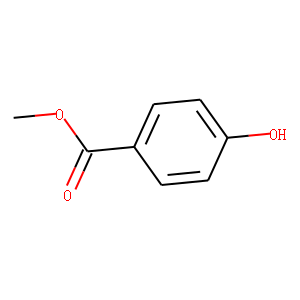| Reference | <p>
<span style="font-family:arial,helvetica,sans-serif;"><span style="font-size:12px;">1.<span style="font-variant-ligatures: normal; orphans: 2; widows: 2;">Mincea, Manuela M., et al. "Determination of methylparaben from cosmetic products by ultra performance liquid chromatography." </span><i style="font-family: Arial, sans-serif; font-size: 13px; font-variant-ligatures: normal; orphans: 2; widows: 2;">Journal of the Serbian Chemical Society</i><span style="font-variant-ligatures: normal; orphans: 2; widows: 2;"> 74.6 (2009): 669-676.<br />
2.</span><span style="font-variant-ligatures: normal; orphans: 2; widows: 2;">Okamoto, Yoshinori, et al. "Combined activation of methyl paraben by light irradiation and esterase metabolism toward oxidative DNA damage." </span><i style="font-family: Arial, sans-serif; font-size: 13px; font-variant-ligatures: normal; orphans: 2; widows: 2;">Chemical research in toxicology</i><span style="font-variant-ligatures: normal; orphans: 2; widows: 2;"> 21.8 (2008): 1594-1599.<br />
3.</span><span style="font-variant-ligatures: normal; orphans: 2; widows: 2;">Krzek, Jan, et al. "Simultaneous Determination of Fusidic Acid, m‐and p‐Hydroxybenzoates and Butylhydroxyanisole by TLC with Densitometric Detection in UV." </span><i style="font-family: Arial, sans-serif; font-size: 13px; font-variant-ligatures: normal; orphans: 2; widows: 2;">Journal of liquid chromatography & related technologies</i><span style="font-variant-ligatures: normal; orphans: 2; widows: 2;"> 29.14 (2006): 2129-2139.<br />
4.</span>Biochem Pharmacol. 2013 Nov 1;86(9):1376-96. doi: 10.1016/j.bcp.2013.08.018. Epub 2013 Aug 22.Combining molecular docking and 3-D pharmacophore generation to enclose the in vivo antigenotoxic activity of naturally occurring aromatic compounds: myricetin, quercetin, rutin, and rosmarinic acid.Mladenović M(1), Matić S, Stanić S, Solujić S, Mihailović V, Stanković N, Katanić J.</span></span></p>
<p>
<span style="font-family:arial,helvetica,sans-serif;"><span style="font-size:12px;">Considering the controversial results concerning the antimutagenicity of some phenolic compounds recorded in the literature, the antigenotoxic effects of four selected phenolic compounds, myricetin, quercetin, rutin, and rosmarinic acid, against DNA damage induced by alkylation with ethyl methanesulfonate (EMS), were evaluated in Drosophila melanogaster males using the sex-linked recessive lethal (SLRL) test. To assess the protective effects against DNA damage, D. melanogaster males were exposed to a monofunctional alkylating agent EMS in concentration of 0.75 ppm, 24 h prior to one of the selected phenolic compounds in the concentration of 100 ppm. The possible differences in mechanisms of </span></span><span style="font-family: arial, helvetica, sans-serif;">protection by selected compounds were determined by molecular docking, after which structure-based 3-D pharmacophore models were generated. EMS induced considerable DNA damage as shown by significant increase in the frequency of germinative mutations. The frequency decreased with high significance (p<0.001***) after post-treatments with all selected phenolic compounds. Further, docking analysis revealed EMS pre-bond conformations against guanine and thymine as a necessary condition for alkylation, after which resulting O⁶-ethylguanine and O⁴-ethylthimine were docked into the active site of O⁶-alkylguanine-DNA alkyltransferase to confirm that particular lesions are going to be repaired. Finally, myricetin and quercetin protected dealkylated nucleotides from further EMS alkylation by forming the strong hydrogen bonds with O⁶-guanine and O⁴-thymine via B ring hydroxyl group (bond lengths lower than 2.5 Å). On the other side, rutin and rosmarinic acid encircled nucleotides and by fulfilling the EMS binding space they made an impermeable barrier for the EMS molecule and prevented further alkylation.</span></p>
<div>
</div>
|

